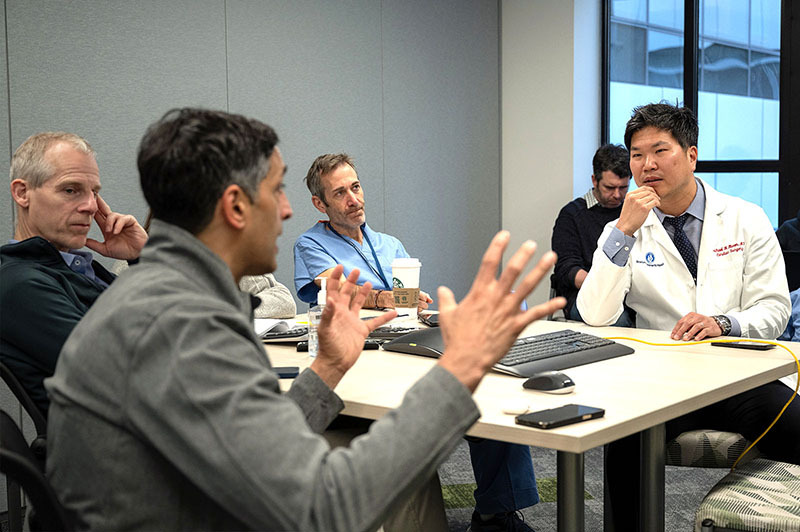Constant improvements make the Ross procedure a safe aortic valve replacement option

Cardiac surgeons understand that innovation isn’t always about invention. Improving something can be just as transformative.
So it shouldn’t come as a surprise that Boston Children’s cardiac surgery team is seeing lasting positive outcomes in patients after making adjustments over the years to the Ross procedure, a last-option treatment for aortic valve disease that hasn’t always been accepted by some heart specialists because of complications. Because most Boston Children’s patients don’t require further surgery for their aortic valve after having a Ross, the surgeons believe their approach makes the procedure an effective treatment option for patients of all ages.
“We have been able to come up with solutions that manage the potential complications that can happen after a Ross procedure,” says cardiac surgeon Christopher Baird, MD, the Benderson Family Chair of Boston Children’s Congenital Heart Valve Program. “We’ve made it a safe, more effective, and durable procedure.”
Wanting to offer a long-lasting replacement aortic valve
The Ross procedure replaces a narrowed or leaky aortic valve by taking advantage of a patient’s own heart anatomy. Their pulmonary valve is surgically moved into the place of the diseased aortic valve. After it is moved, the pulmonary valve immediately and effectively functions as an aortic valve. A replacement pulmonary valve (or conduit valve) from a cadaver donor takes the place of the moved one.
The Ross aims to give patients more time with a replacement aortic valve. Other replacement options are not always as long-lasting or as practical as the Ross, according to cardiac surgeon Michael Kwon, MD. A bioprosthetic (cow or pig) replacement valve will often last no more than 15 years — or fewer in younger children — before needing to be replaced again. A mechanical valve requires a patient to take anticoagulant medication for life to prevent blood clots.
“Many of our teenage and adult patients do not want to rely on an anticoagulant, so they will prefer a Ross,” says Gerald Marx, MD, a Boston Children’s cardiologist. “For infants whose aortic valves can’t be repaired, a mechanical or prosthetic valve won’t work because they’re not small enough to fit. That’s why the Ross is advantageous for infants, because the pulmonary valve is going to fit in the aortic valve position most of the time, and it will grow with the patient.”
Seeing promise in the Ross procedure despite complications
At first a popular surgical option after its invention in 1967, the Ross procedure fell out of favor for a few years because of long-term complications. One complication was the replacement aortic valve expanded and leaked in patients who have a large aortic annulus. Also, some cardiologists disapproved of the Ross, pointing to how a procedure that’s meant to replace one heart valve becomes more involved because a second valve (the conduit valve) also needs to be monitored after surgery and potentially replaced.

Some heart centers still prefer to not perform the Ross procedure due to some of the operation’s technical complexities and the potential for long-term complications. Boston Children’s offers it to adults and children after surgeons and cardiologists focused on improving it. The procedure has too much value to patients to avoid it, Kwon says. To prevent complications, Boston Children’s surgeons now take additional steps, depending on a patient’s heart anatomy. Those steps include positioning the valve in a spot on the heart where it won’t dilate and supporting the new aortic valve with graft material to prevent dilation and leakage.
“These are just different technical maneuvers that prevent the new valve from dilating and causing leakage, which happened in about 30 percent of patients who had the procedure,” Baird says. Some of these techniques and methods were developed at Boston Children’s; others were created at other heart centers but adopted and refined by the Boston Children’s surgeons.
Meanwhile, advances in interventional cardiology have increased the longevity of the conduit pulmonary valve. If a conduit valve has significant obstruction, it can be dilated or stented in a catheterization laboratory, Marx says. If it is leaking or no longer adequate, a new valve can be placed through catheterization.
Ross patients have favorable post-surgery outcomes
With many heart centers again viewing the procedure favorably, Kwon and colleagues thought it would be ideal to look back on Boston Children’s track record. Their data, which is currently being analyzed for future publication, revealed:
- Only one of 58 patients who weighed more than 40 kilograms and had the Ross procedure over the last 17 years needed any further surgical intervention for the new aortic valve, while only three of them needed another pulmonary conduit replacement or an intervention.
- Of the 86 patients who had a Ross procedure over that time and weighed less than 40 kilograms, eight needed additional surgical intervention for the new aortic valve, while 13 needed another pulmonary conduit replacement or an intervention.
- Seventy-five percent of the patients previously had another type of heart surgery, which increased risks during the Ross procedure.
- Over 35 percent of them needed an additional procedure during the same operation as the Ross, adding more complexity to surgery.
“Those outcomes are a powerful message when patients ask if they should have a Ross,” Kwon says. “We’re able to show that even with the added complexity of surgery that has additional procedures or is a re-operative surgery, outcomes for our Ross patients can still be excellent. Our survival rate is 100 percent, and the risk of reoperation for either the aortic or the conduit pulmonary valve is very low.”
The Ross procedure and other aortic valve replacement procedures are last-resort measures; repairing the valve is always the first priority, Marx says. But he says evidence shows that the new valve from a Ross can last as long as 30 years, especially in teenage and adult patients.
“The new aortic valve from a Ross procedure doesn’t undergo degenerative changes,” Marx says. “We don’t fully understand why, but my guess is the body doesn’t recognize it as foreign tissue.”
Learn more about the Department of Cardiac Surgery or refer a patient.
Related Posts :
-

Mending injured hearts: Lessons from newborns?
When the heart is injured, as in a myocardial infarction, the damaged heart muscle cannot regenerate — instead, scar tissue forms. ...
-

Finding ways to reduce the financial and social costs of pacemakers
As the number of complex heart operations has increased over the years, so have cases of postoperative heart block, a ...
-

Helping aspiring clinicians understand a virtual heart before they work with a real one
Jonathan Awori, MD, MS, MFA, isn’t embarrassed to say it took him a long time to completely understand the ...
-

Research aims to pinpoint genetic connection between autism and heart disease
Cardiology and neurodevelopmental researchers have more questions than answers about the possible genetic links between congenital heart disease (CHD)&...





